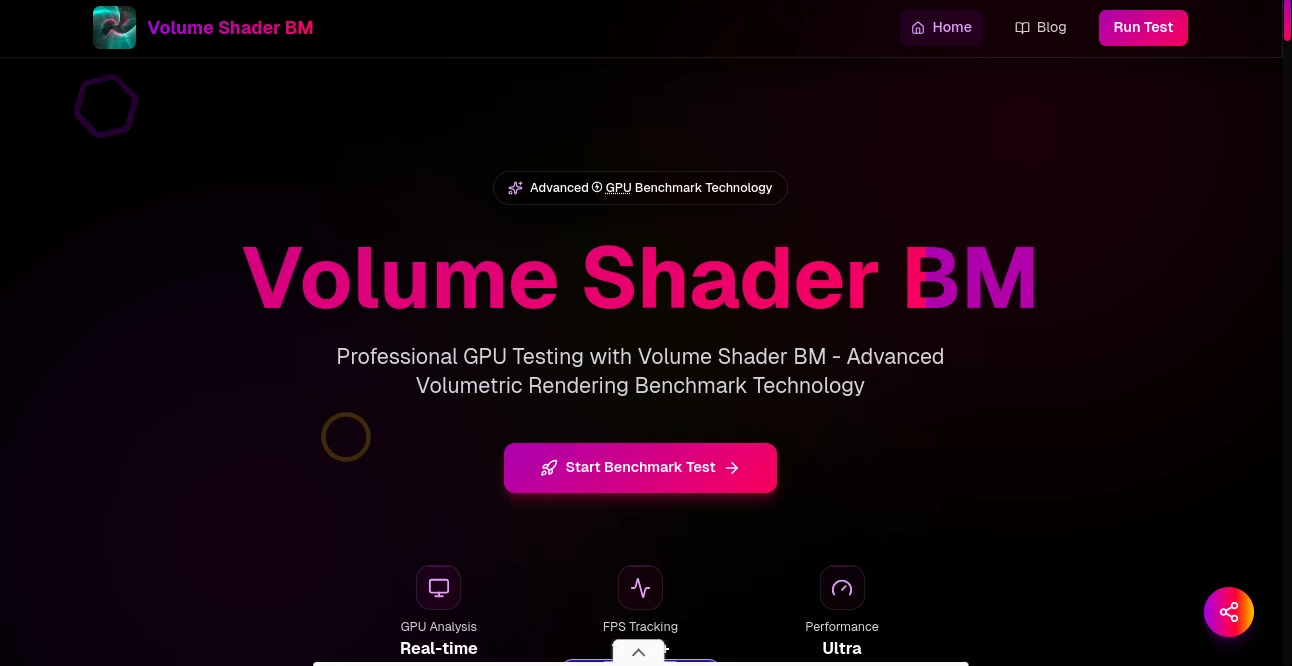volume shader
Push Your GPU to Volumetric Limits

What is volume shader?
Volume Shader BM steps in as a no-fuss way to gauge how your graphics hardware handles the heavy lifting of three-dimensional haze and fog effects in games and apps. This browser-based tester dives into the guts of ray-based drawing techniques, spitting out numbers that tell you if your setup's ready for the next big visual leap. Hardware tinkerers and game builders alike keep it bookmarked for those moments when they wonder if an upgrade will actually pay off in smoother scenes.
Introduction
Volume Shader BM cropped up a few years ago amid the buzz around fancier light tricks in titles that make worlds feel alive with mist and glows. A handful of tech heads, fresh off tweaking engines for indie hits, threw it together to fill a gap—no one else was zeroing in on these space-filling renders that chew through pixels like candy. Word got around fast in forums where folks swap tales of frame drops during stormy cutscenes, and now it's a quiet staple for anyone chasing that edge in hardware know-how. What grabs hold is its straight-shooter vibe: fire it up, let it run, and walk away with facts that cut through the hype of spec sheets.
Key Features
User Interface
You hit the page and it's all there in a single pane—no menus to hunt or logins to fuss over. The big button up top begs a click to kick things off, and as scenes swirl into view, counters tick away in the corner like a heartbeat monitor. Graphs unfurl at the end, simple lines tracing dips and peaks, with labels that explain themselves without a glossary. It's the kind of setup that lets you lean back, sip something cold, and trust it'll wrap up without babysitting.
Accuracy & Performance
It clocks your rig's true grit, mirroring the grind of actual scenes where light bounces through clouds, down to the tiniest stutter. Runs wrap in under a minute on beefy cards, yet it sniffs out weak spots like heat buildup that tanks frames later on. Testers nod at how its scores line up with real dips in demanding levels, giving you numbers you can bank on without second-guessing the math.
Capabilities
The tester throws a gauntlet of fractal swirls and ray-traced hazes your way, probing how fast it chews through math-heavy loops that build entire volumes from thin air. It sizes up shader load times too, flagging if your setup chokes on compiling the fancy code that makes fog roll just so. From desktop beasts to pocket slabs, it dials down the heat for fair shakes, handing over breakdowns that spotlight where your gear shines or strains.
Security & Privacy
Since it all happens right in your browser window, nothing sticks around after the tab closes—no sneaky logs or profile pokes. It pulls just enough from your hardware to run the show, then lets go clean, leaving your setup untouched and your data out of the mix. Folks breathe easy knowing it's a one-and-done scan that doesn't whisper your specs to anyone else.
Use Cases
Indie coders fire it up mid-project to check if their misty realms will hum on average rigs, tweaking code before launch day blues hit. Gamers eyeing a card swap run it side-by-side with old scores, weighing if the extra cash buys real zip in foggy firefights. Lab coats in imaging labs use it to vet machines for slicing through scan data without lag, while hobby modders baseline their overclocks to brag about stable highs in group chats.
Pros and Cons
Pros:
- Zero install hassle— just point and click in any modern browser.
- Pinpoints volumetric weak links that broad tests gloss over.
- Works across gadgets, from towers to tablets, for quick checks.
Cons:
- Skips the full suite of polygon pounds other benchmarks pack.
- Mobile scores skew low due to built-in brakes on power draw.
- Lacks deep dives into power pulls or noise levels.
Pricing Plans
It's wide open at no charge, letting anyone dive in for as many rounds as they fancy without a wallet hit. The core run delivers all the meaty metrics, and while whispers hint at premium graphs down the line, right now it's pure gift—run it till your browser blues screens if you like.
How to Use Volume Shader BM
Swing by the test spot in your go-to browser, give it a sec to sniff out your graphics muscle, then smack that start key. Sit tight as it spins up swirling voids and misty marches, eyes on the live tickers for any early wobbles. When the dust settles, pore over the wrap-up charts, jot the scores, and rerun after your next driver dance or fan curve fiddle to spot the shifts.
Comparison with Similar Tools
Broad suites like those from synthetic heavyweights cast wide nets on triangles and textures, but Volume Shader BM lasers in on the foggy frontiers they barely brush, making it the sharper pick for vapor-heavy visions. Against web rivals, it edges with tighter timings and fractal flair, though those might bundle more bells for general gear grinds. It carves its niche for folks who live in the haze, delivering depth where others skim surfaces.
Conclusion
Volume Shader BM boils down the black box of graphics grunt to clear-cut calls on handling those immersive mists that make scenes sing. It arms tinkerers and creators with the straight dope to chase smoother skies, turning 'maybe it'll run' into 'yeah, it'll fly.' In a field racing toward richer renders, this little engine keeps your hardware honest, one volumetric verdict at a time.
Frequently Asked Questions (FAQ)
Why zero in on volume stuff over plain shapes?
It mirrors the next wave of effects like god rays through smoke, stuff polygons alone can't touch.
Will it play nice on my laptop?
Sure, if WebGL's lit, though expect dialed-back dreams to match the thermals.
How often should I rerun it?
After any big swap or software shuffle, to catch if gains stick or slip.
Does it flag overheating spots?
Graphs show frame fades that scream thermal tantrums, yes.
Any need for fancy drivers?
Fresh ones help for peak reads, but it hums on stock setups too.
AI 3D Model Generator , AI Image to 3D Model , AI Diagram Generator .
These classifications represent its core capabilities and areas of application. For related tools, explore the linked categories above.
volume shader details
Pricing
- Free
Apps
- Web Tools
















